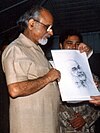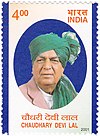Janata Dal
 From Wikipedia - Reading time: 11 min
From Wikipedia - Reading time: 11 min
Janata Dal | |
|---|---|
 | |
| Abbreviation | JD |
| Founder | V. P. Singh |
| Founded | 11 October 1988 |
| Dissolved | 2003 |
| Merger of | |
| Succeeded by | |
| Political position | Centre[2] |
| National affiliation |
|
| Colours | Green |
Janata Dal ("People’s Party") was an Indian political party which was formed through the merger of Janata Party factions, the Lok Dal, Indian National Congress (Jagjivan), and the Jan Morcha united on 11 October 1988 on the birth anniversary of Jayaprakash Narayan under the leadership of V. P. Singh.[3][4]
History
[edit]V. P. Singh united the entire disparate spectrum of parties ranging from regional parties such as the Telugu Desam Party, the Dravida Munnetra Kazhagam, and the Asom Gana Parishad, together and formed the National Front with N. T. Rama Rao as President and V. P. Singh as convenor. The front also included outside support from the right-wing Bharatiya Janata Party and the left-wing Left Front, led by the Communist Party of India and Communist Party of India (Marxist). They defeated Rajiv Gandhi's Congress (I) in the 1989 parliamentary elections.[5][6] His government fell after Lalu Prasad Yadav got Advani arrested in Samastipur and stopped his Ram Rath Yatra, which was going to Ayodhya on the site of the Babri Masjid on 23 October 1990, and the Bharatiya Janata Party withdrew support. V. P. Singh lost a parliamentary vote of confidence on 7 November 1990.[7] In the 1991 Indian general election the Janata Dal lost power but emerged as the third largest party in Lok Sabha.[8] The Janata Dal-led United Front formed the government after the 1996 Indian general election with the outside support of the Indian National Congress. However, after this the Janata Dal gradually disintegrated into various smaller factions, which largely became regional parties such as Biju Janata Dal, Rashtriya Janata Dal, Janata Dal (Secular) and Janata Dal (United).[9]
Ascent to power
[edit]
It first came to power in 1989, after cases of corruption, known as the Bofors scandal, caused Rajiv Gandhi's Congress (I) to lose the elections. The National Front coalition that was formed consisted of the Janata Dal and a few smaller parties in the government, and had outside support from the Left Front and the Bharatiya Janata Party. V. P. Singh was the prime minister. In November 1990, this coalition collapsed, and a new government headed by Chandra Shekhar under Samajwadi Janata Party (Rashtriya) which had the support of the congress came to power for a short while. Two days before the vote, Chandra Shekhar, an ambitious Janata Dal rival who had been kept out of the National Front government, joined with Devi Lal, a former deputy prime minister under V. P. Singh, to form the Samajwadi Janata Party, with a total of just sixty Lok Sabha members. The day after the collapse of the National Front government, Chandra Shekhar informed the president that by gaining the backing of the Congress (I) and its electoral allies he enjoyed the support of 280 members of the Lok Sabha, and he demanded the right to constitute a new government. Even though his rump party accounted for only one-ninth of the members of the Lok Sabha, Chandra Shekhar succeeded in forming a new minority Government and becoming Prime Minister (with Devi Lal as deputy prime minister). However, Chandra Shekhar's government fell less than four months later, after the Congress (I) withdrew its support.[10]

Its second spell of power began in 1996, when the Janata Dal-led United Front coalition came to power, with outside support from the congress under Sitaram Kesri, choosing H. D. Deve Gowda as their prime minister. The Congress withdrew their support in less than a year, after the H. D. Deve Gowda Government restarted probing the corruption cases against a lot of Congress leaders, hoping to gain power with the support of various United Front constituent groups, and I. K. Gujral became the next prime minister. His government too fell in a few months, and in February 1998, the Janata Dal-led coalition lost power to the Bharatiya Janata Party in General Elections.[citation needed]
List of prime ministers & chief ministers of India
[edit]Prime ministers
[edit]| No. | Image | Prime ministers | Year | Duration | Constituency |
|---|---|---|---|---|---|
| 1 |  |
Vishwanath Pratap Singh | 1989 – 1990 | 343 days | Fatehpur |
| 2 |  |
H. D. Deve Gowda | 1996 – 1997 | 324 days | — (Rajya Sabha MP) from Karnataka |
| 3 |  |
Inder Kumar Gujral | 1997 – 1998 | 332 days | — (Rajya Sabha MP) from Bihar |
Chief ministers
[edit]| No. | Portrait | Chief Ministers | State | Year | Duration |
|---|---|---|---|---|---|
| 1 |  |
Mulayam Singh Yadav | Uttar Pradesh | ||
| 2 | Chimanbhai Patel | Gujarat | |||
 |
Lalu Prasad Yadav | Bihar | |||
 |
Biju Patnaik | Odisha | |||
 |
H. D. Deve Gowda | Karnataka | |||
| J. H. Patel | Karnataka | ||||
 |
Devi Lal | Haryana | |||
 |
Om Prakash Chautala | Haryana | |||
 |
Banarsi Das Gupta | Haryana | |||
| Hukum Singh | Haryana |
Electoral records
[edit]| Year | Seats won | Votes | ||
|---|---|---|---|---|
| 1989 Indian general election | 143 | 53,518,521 | ||
| 1991 Indian general election | 59 | 32,628,400 | ||
| 1996 Indian general election | 46 | 27,070,340 | ||
| 1998 Indian general election | 6 | 11,930,209 | ||
| Party Disintegrated | ||||
Vice President & Deputy Prime Minister of India
[edit]| No. | Portrait | Vice President | Year | Duration |
|---|---|---|---|---|
| 1 | 
|
Krishan Kant | 21 August 1997 – 27 July 2002 | 4 years, 340 days |
| No. | Portrait | Deputy Prime Minister | Year | Duration |
|---|---|---|---|---|
| 1 | 
|
Devi Lal | 10 November 1990 – 21 June 1991 | 242 Days |
Party presidents & deputy chief ministers
[edit]| No. | Portrait | Presidents | Year | Duration |
|---|---|---|---|---|
| 1 |  |
Vishwanath Pratap Singh | 1989-1997 | days |
| 2 |  |
Sharad Yadav | 1997-1999 | days |
| No. | Portrait | Deputy Chief Minister | State | Year | Duration |
|---|---|---|---|---|---|
| 1 | Banarsi Das Gupta | Haryana | |||
| 2 | Hukam Singh | Haryana | |||
| J. H. Patel | Karnataka | ||||
| K. Siddaramaiah | Karnataka |
National units
[edit]
Thakur Ji Pathak (1989 – 1994)- National General Secretary [11]
State units
[edit]Uttar pradesh
[edit]Anantram Jaiswal (1983)
Karnataka
[edit]Presidents
[edit]B. Rachaiah (1989)[12]
Siddaramaiah (Feb 1999)[13]
C. Byre Gowda (July 1999)[14]
General Secretary
[edit]Jeevaraj Alva (1989-1990)[15][12]
C. Narayanaswamy (1999)[14]
Tamil Nadu
[edit]President
[edit]Sivaji Ganesan (1989-1993)
Janata Dal factions
[edit]Defunct parties
[edit]- Jan Adhikar Party (Loktantrik) led by Pappu Yadav (merged with Indian National Congress).
- Samajwadi Janata Party (Rashtriya) of Late Chandra Shekhar is now defunct because of weak leadership.
- Samajwadi Janata Dal (Democratic) led by Devendra Prasad Yadav (merged with Rashtriya Janata Dal).
- Bharatiya Sablog Party led by Arun Kumar (merged with Lok Janshakti Party (Ram Vilas)).
- Lok Janshakti Party of Late Ram Vilas Paswan and led by Chirag Paswan (split into the Lok Janshakti Party (Ram Vilas) led by Ram's son Chirag Paswan, and the Rashtriya Lok Janshakti Party led by Ram's brother Pashupati Kumar Paras).
- Rashtriya Lok Samta Party led by Upendra Kushwaha (merged with Janata Dal United).
- Loktantrik Janata Dal led by Late Sharad Yadav (merged with Rashtriya Janata Dal).
- Socialist Janata Party led by Manju Mohan (merged with Socialist Party (India)).
- Samras Samaj Party led by Nagmani (merged with Rashtriya Lok Samta Party).[16]
- Samata Party of Late George Fernandes (merged with Janata Dal (United)).
- Socialist Janata (Democratic) led by Late M. P. Veerendra Kumar (merged with Janata Dal (United))[17][18]
- Jan Morcha of Late V. P. Singh and led by Ajeya Pratap Singh (merged with Indian National Congress).
- Odisha Jan Morcha is defunct because of weak leadership.
- Odisha Gana Parishad led by Bijoy Mohapatra (merged with Nationalist Congress Party).
- All India Progressive Janata Dal led by Late Ramakrishna Hegde and late S. R. Bommai (merged with Janata Dal (United)).
- Janata Dal (Left) led by Late Surendra Mohan and Late M. P. Veerendra Kumar (merged with Janata Dal (Secular)).
- Lok Shakti led by Late Ramakrishna Hegde (merged with Janata Dal (United)).
- Pragatisheel Samajwadi Party (Lohiya) led by Shivpal Singh Yadav (merged with Samajwadi Party).
- Janata Dal (Gujarat) led by Late Chimanbhai Patel and Late Chhabildas Mehta (merged with Indian National Congress).
- Janata Dal (Digvijay) led by Digvijay Singh (merged with Bharatiya Janata Party).
- Janata Dal (Ajit) led by Late Ajit Singh (merged with Indian National Congress).
- Janata Dal (Socialist) led by Late Chandra Shekhar, Late Devi Lal, Late Mulayam Singh Yadav (renamed as Late Samajwadi Janata Party (Rashtriya)).
- Punjab Janata Morcha (PJM), in English the Punjab Popular Front, was a Sikh political party in the Indian state of Punjab. The party formed in 1989 as a splinter group of the Janata Dal. The party failed to win any election seats in its lifetime. Party president Kirpal Singh announced that the PJM was disbanded in 1997. Most members joined the Jan Morcha by 2003.[19]
See also
[edit]References
[edit]- ^ Samata Party, archived from the original on 15 February 2022, retrieved 15 February 2022
- ^ "Why the Far Right Rules Modi's India". Jacobin. Retrieved 4 June 2024.
In this vacuum, the BJP's path to power followed that of three other centrist parties, similar to Congress, which led coalitions on three separate occasions.
- ^ N. Jose Chander (1 January 2004). Coalition Politics: The Indian Experience. Concept Publishing Company. pp. 35–. ISBN 978-81-8069-092-1. Retrieved 31 October 2015.
- ^ India Since Independence: Making Sense of Indian Politics. Pearson Education India. 2010. pp. 334–. ISBN 978-81-317-2567-2. Retrieved 31 October 2015.
- ^ "V. P. Singh, a Leader of India Who Defended Poor, Dies at 77". New York Times. 29 November 2008. Retrieved 31 October 2015.
- ^ Indian Parliamentary Democracy. Atlantic Publishers & Dist. 2003. pp. 124–. ISBN 978-81-269-0193-7. Retrieved 1 November 2015.
- ^ "India's Cabinet Falls as Premier Loses Confidence Vote, by 142-346, and Quits". New York Times. 8 November 1990. Retrieved 1 November 2015.
- ^ "India Parliamentary Chamber: Lok Sabha Elections Held in 1991". Inter-Parliamentary Union. Retrieved 1 November 2015.
- ^ "Lalu green signal for Janata Parivar unity". Madan Kumar. The Times of India. 5 April 2015. Retrieved 1 November 2015.
- ^ Srivastava, Aaku (2022). Sensex of Regional Parties. Prabhat Prakashan Pvt. Limited. ISBN 978-93-5521-236-8. Retrieved 21 July 2024.
- ^ "india-today". indiatoday.com.
- ^ a b Rajghatta, Chidanand; 31 March 1989 (31 March 1989). "Karnataka unit Janata Dal gets a president". India Today. Retrieved 22 August 2021.
{{cite web}}: CS1 maint: numeric names: authors list (link) - ^ "Rediff On The NeT: Spectre of split returns to haunt JD". inwww.rediff.com. Retrieved 13 December 2021.
- ^ a b Menon, Parvathi. "The fallout in Karnataka". Frontline. Archived from the original on 13 December 2021. Retrieved 13 December 2021.
- ^ Raj Chengappa (15 September 1988). "Karnataka's new CM S.R. Bommai inherits a troubled legacy". India Today. Retrieved 17 August 2021.
- ^ "Samras Samaj Party merges into RLSP". News.webindia123.com. Archived from the original on 7 April 2020. Retrieved 22 September 2018.
- ^ "Nitish Kumar hails SJD's merger with JD-U in Kerala : South, News - India Today". Indiatoday.intoday.in. 29 December 2014. Retrieved 12 March 2017.
- ^ "SJD Merges with Sharad Yadav's Janata Dal (United)". The New Indian Express. 29 December 2014. Archived from the original on 31 December 2014. Retrieved 12 March 2017.
- ^ "From Lucknow to Delhi, parties that died with their founders". The Indian Express. 24 December 2016. Retrieved 27 June 2018.
- ^ "Samata Party – Official Website". Archived from the original on 15 February 2022. Retrieved 25 April 2022.
 KSF
KSF